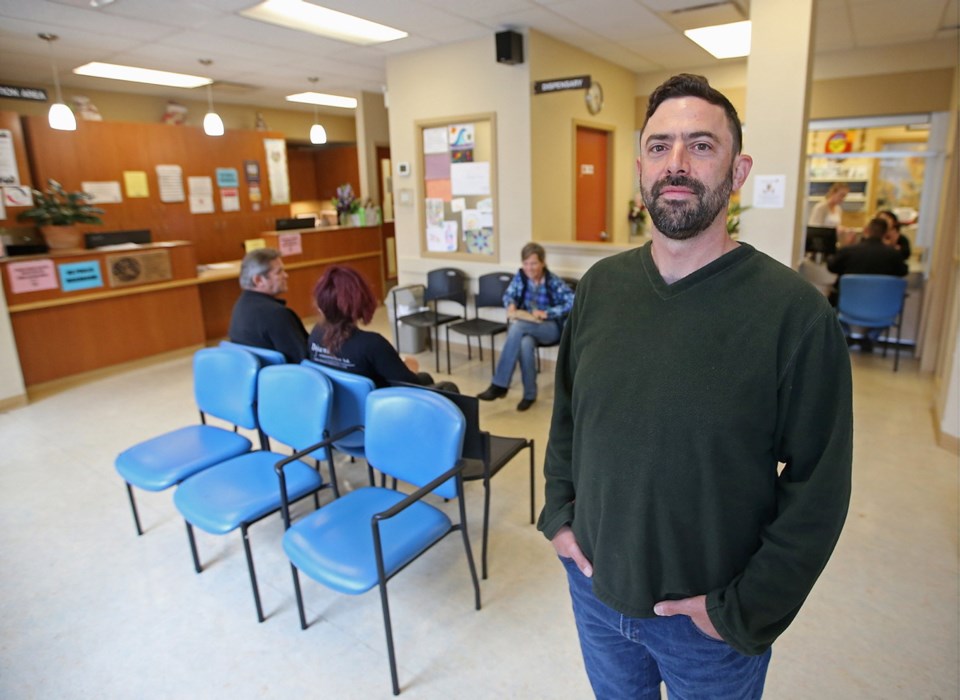Grey Showler is a bit of an anomaly these days.
At a time when medical clinics are struggling to attract and retain family doctors, Showler has physicians coming to him, inquiring about openings at Victoria Cool Aid Society’s community health centre.
“People want to work here,” he says. “I get people asking if we have opportunities.”
Showler, Cool Aid’s director of health and support services, says that’s partly because doctors at the Johnson Street clinic get to work with a multi-disciplinary team whose members share the load of caring for inner-city patients — many of whom struggle with homelessness, poverty, mental health and substance-use issues.
The clinic employs the equivalent of nearly five family doctors as well as registered nurses, counsellors, medical office assistants, a dietitian and a physiotherapist. There’s also a pharmacy and a fully staffed dental clinic on site.
A system of shared electronic medical records ensures that patients don’t have to repeat their story every time they see a new team member.
And staff doctors get paid a salary rather than relying on the province’s fee-for-service model, where compensation depends on how many patients a physician sees and how many procedures they perform.
“Instead of the doctors constantly having to worry about volume, they’re able to take the time and stop and work with the team,” said Showler, president of the B.C. Association of Community Health Centres. “If you have patients with more complexity or that require extra attention, [the doctors] can take that time and do it.
“The doctor that’s doing fee-for-service billing, paying for their medical office assistant, paying for their rent — they really have to worry about the bottom line. So they have to make sure that they’re seeing enough patients all the time.”
Showler argues that Cool Aid’s centre provides more efficient care because other team members share the workload.
“A lot of family doctors in B.C. spend a lot of time doing things that other people can be doing and at less cost to the system,” he said. “For example, at Cool Aid Community Health Centre, about half of our visits in any given year are not with a physician. If you come in and you have diabetes and you want to talk about your diet, you talk to the dietitian.”
The doctors, meanwhile, get to focus on physician work and don’t have to worry about running a business, since that side is left to Showler and the society’s board of directors.
“It’s a really high quality of job satisfaction for [the doctors],” he said.
It’s also one of the reasons that community health centres are being touted as a way to improve access to primary health care in B.C. and Greater Victoria, where thousands of people have no family doctor.
Dr. Chris Fraser, the centre’s medical director, said he realized early in his career that a community health centre was the way to optimize the skillsets of a wide range of health professionals. “Whether it’s physicians, nurses, pharmacists — the more we work in an integrated, interdisciplinary team, the better everyone does in working to their full capacity.”
Fraser noted that jurisdictions in Europe and across the developed world have recognized that integrated teams are the best way to provide primary care to an aging population.
“It’s really the way of the future,” he said. “I think all physicians are open to this now to be part of integrated teams.”
That wasn’t always the case. A report by the Canadian Centre for Policy Alternatives says community health centres have struggled to take hold in B.C. partly because doctors resisted switching from the fee-for-service model to alternative forms of compensation.
Andrew Longhurst, who co-authored the report, said that attitude appears to be changing as new medical school graduates seek places where they can work in teams, enjoy a better work-life balance and focus on patient care rather than having to run an office, pay rent and hire staff.
“That 1960s model of opening basically a small business and working fee-for-service is not attractive to a new generation of family-medicine graduates,” he said.
His report shows there’s also mounting evidence that community health centres offer a more cost-effective way of delivering care.
A study that compared community health centres to other primary-care models in Ontario found the centres were “more effective in managing chronic conditions, reducing emergency visits, and improving access to care for people with serious mental health issues,” the report says.
One of the problems in B.C., however, is that most community health centres lack a stable source of money.
A position paper by the B.C. Association of Community Health Centres noted that only eight per cent of the centres in B.C. receive core operating funds from the provincial government.
Cool Aid’s community health centre, for instance, receives the bulk of its funding from Island Health, but supplements that with money from community grants and fundraising — something that all community health centres do.
Despite the financing challenges, community health centres are starting to get more attention in B.C. as communities search for ways to attract family doctors and improve primary care.
B.C. Health Minister Adrian Dix has pledged to open more community health centres as part of the province’s primary-care reforms. But advocates of the model want him to pick up the pace.
“That’s one really good model that has all the evidence that tells us that it is cost-effective, it’s attractive to work at, and patient outcomes are better than almost any other structure of primary care,” said Dr. Rita McCracken, a family physician and researcher at the University of B.C. “But in British Columbia, we still don’t have it happening.”



